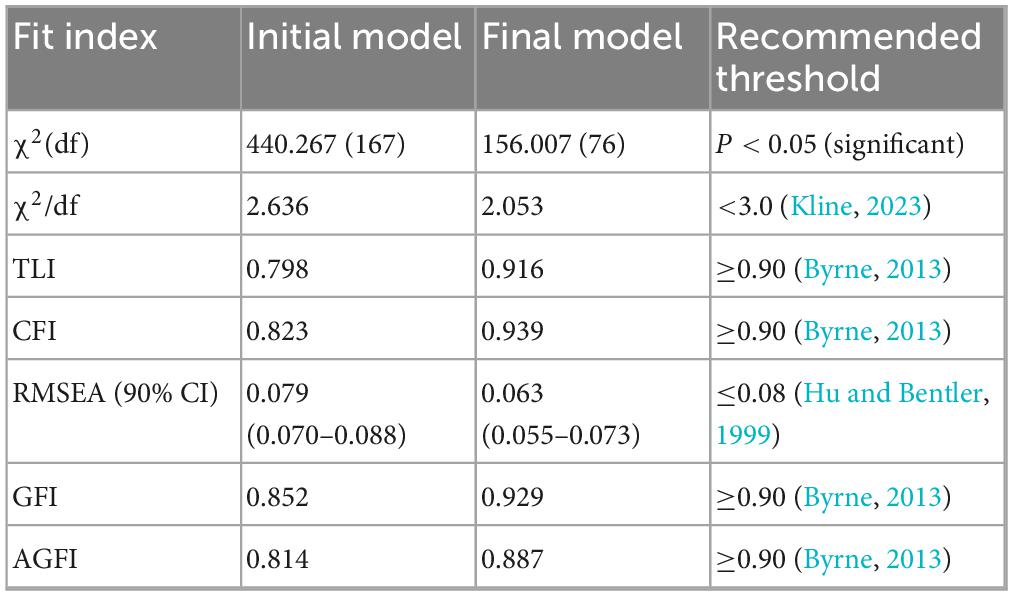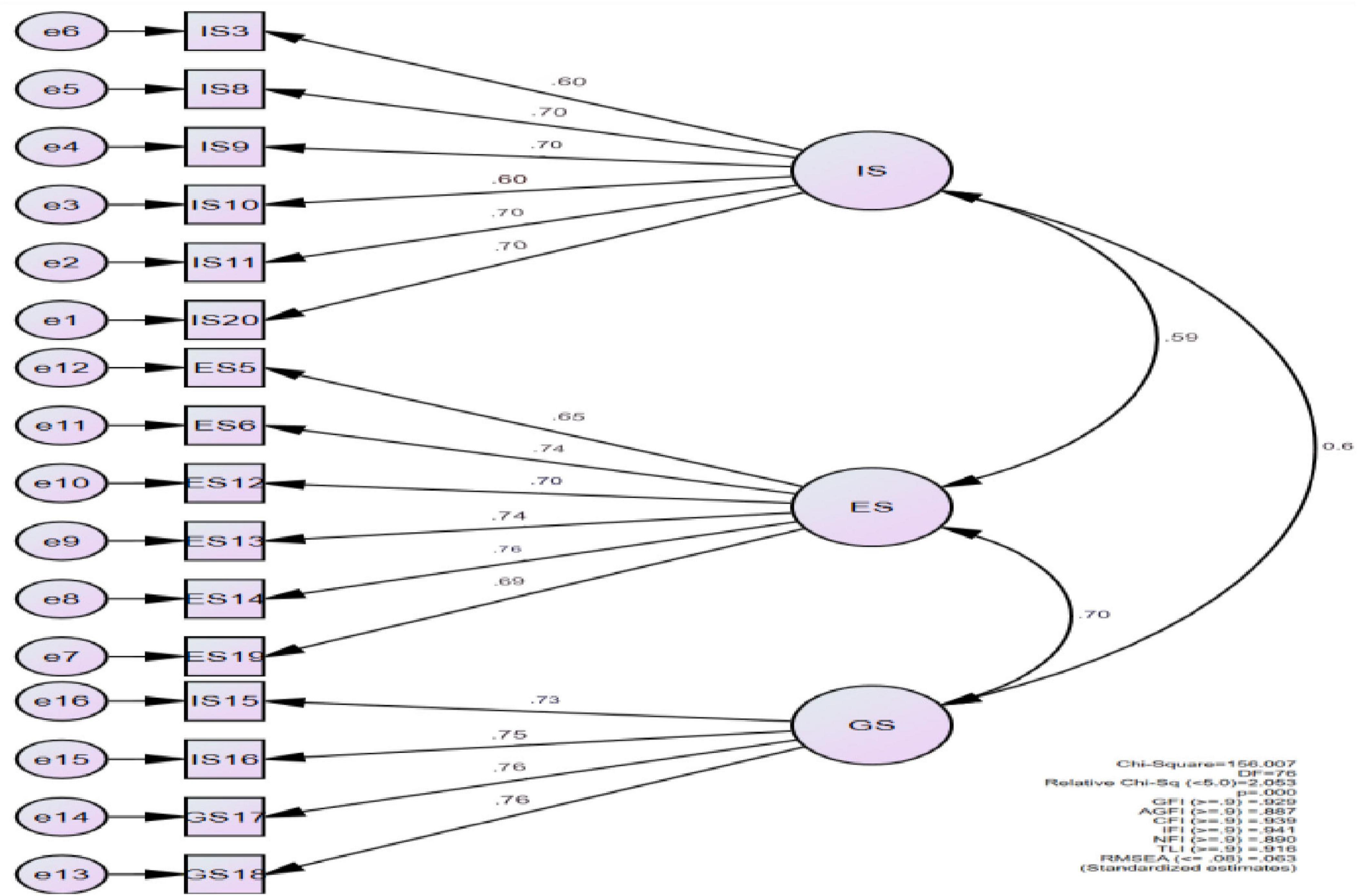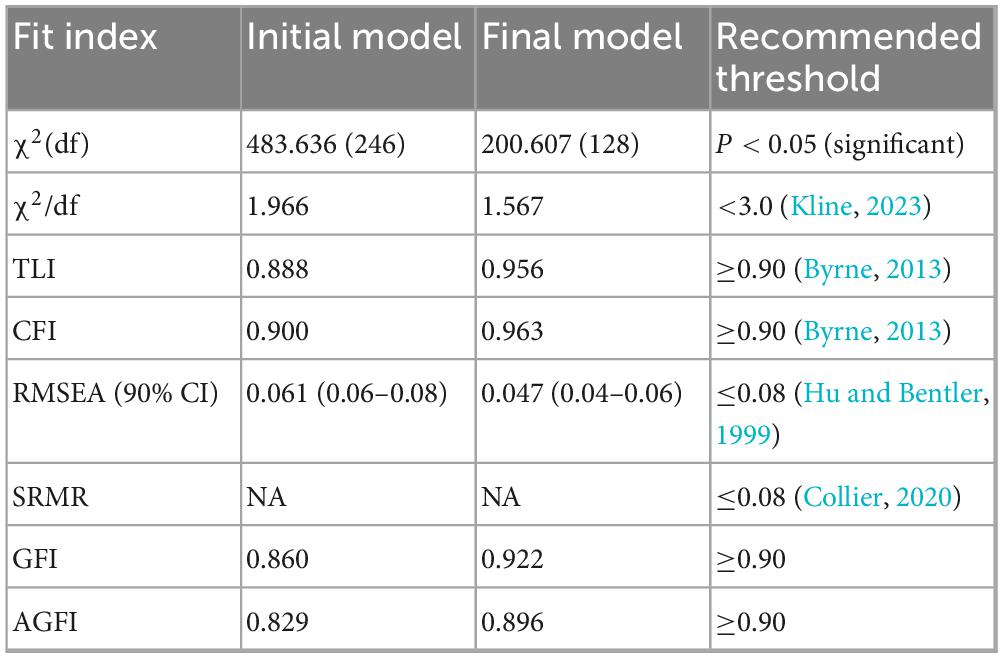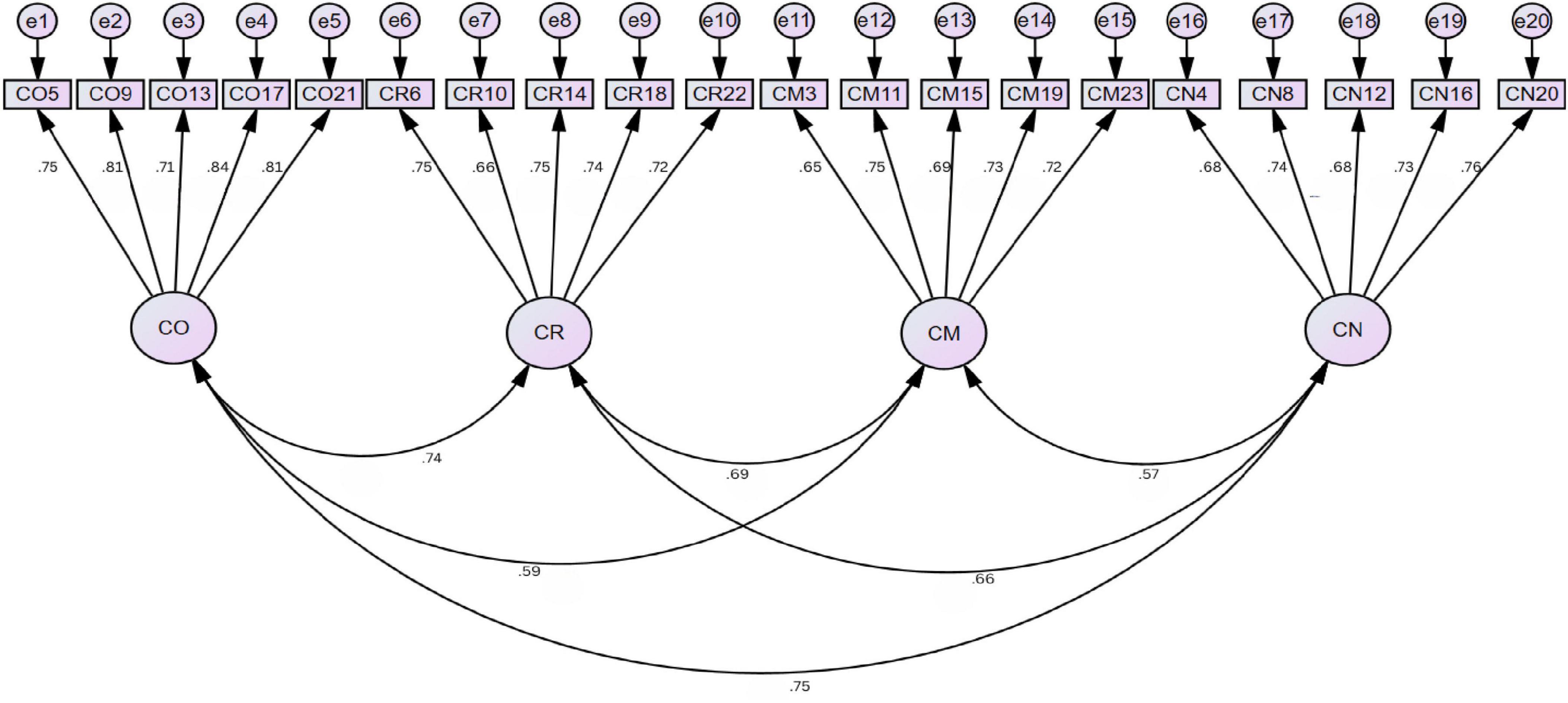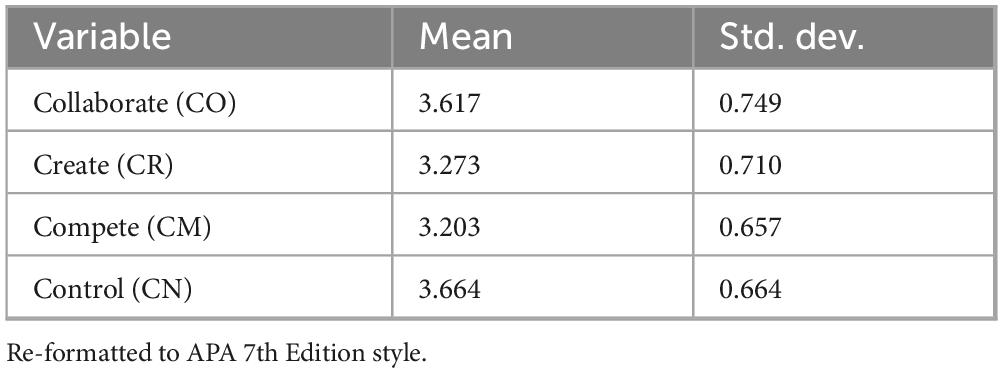- 1Department of Educational Planning and Management, College of Education and Behavioral Sciences, Haramaya University, Haramaya, Ethiopia
- 2Faculty of Education, Amoud University, Borama, Somaliland
- 3Department of Educational Planning and Management, Addis Ababa University, Addis Ababa, Ethiopia
- 4Department of Special Needs and Inclusive Education, Haramaya University, Dire Dawa, Ethiopia
- 5Department of Educational Planning and Management, College of Education and Behavioral Sciences, Haramaya University, Haramaya, Oromia, Ethiopia
Introduction: This study examines the influence of organizational culture (OC) on academic staff job satisfaction (JS) within higher education institutions (HEIs) in the unique post-conflict context of Somaliland. The research highlights the importance of aligning organizational culture with faculty needs to improve retention, motivation, and institutional effectiveness.
Methods: Using data from 266 academic staff and guided by the Competing Values Framework (CVF), four culture types—Collaborate (Clan), Create (Adhocracy), Compete (Market), and Control (Hierarchy)—were assessed alongside three dimensions of job satisfaction: General (GJS), Intrinsic (IJS), and Extrinsic (EJS). Structural Equation Modeling (SEM) was employed to analyze the predictive relationships.
Results: Descriptive results showed that Control (M = 3.66, SD = 0.66) and Collaborate (M = 3.62, SD = 0.75) cultures were the most prevalent. Intrinsic job satisfaction (M = 3.64, SD = 0.52) was the highest reported satisfaction facet, while extrinsic satisfaction (M = 3.32, SD = 0.74) was the lowest. The SEM analysis revealed that Collaborate culture significantly predicted all three satisfaction dimensions (β = 0.50–0.74, p < 0.05). Create and Compete cultures positively influenced IJS and EJS, while Control culture enhanced GJS (β = 0.32, p < 0.05) and IJS (β = 0.46, p < 0.05) but had a non-significant negative effect on EJS.
Discussion: These findings suggest that collaborative, innovative, and structured environments foster job satisfaction in various forms, though their impact varies across satisfaction domains. The study underscores a crucial psychological tension between the institutional need for structural stability and the academic staff’s inherent need for professional autonomy and recognition, offering key insights for institutional leaders and policymakers in Somaliland.
Introduction
Higher Education Institutions (HEIs) play a vital role in societal progress, with their success largely dependent on the job satisfaction (JS) and motivation of their academic staff (Akanji et al., 2020). A content academic workforce is essential for high-quality teaching, research productivity, and the institution’s reputation. In developing regions like Somaliland, where HEIs have rapidly grown despite limited resources and post-conflict recovery challenges, understanding and enhancing faculty JS is even more crucial. Organizational culture (OC), which includes shared values and practices, significantly influences employee attitudes and behaviors. Job satisfaction, in turn, affects key outcomes like performance, retention, and institutional loyalty (Abawa and Obse, 2024).
The context of Somaliland is distinct from the stable, resource-rich Western, Educated, Industrialized, Rich, and Democratic (WEIRD) societies where the majority of organizational research is conducted (Kasalak et al., 2022). Somaliland represents a post-conflict, developing region characterized by a national culture high in power distance and collectivism, severe resource constraints, and a nascent institutional framework that is still solidifying (Kebede and Demeke, 2017). This unique environment fundamentally shapes how leadership is enacted, how organizational cultures are formed, and what factors drive job satisfaction. For instance, in a resource-scarce environment, extrinsic factors like job security may be far more salient drivers of satisfaction than in more affluent contexts.
Despite its recognized importance, there is a “gap in empirical research” on these dynamics within the Somali higher education context. This study seeks to fill this gap by using Structural Equation Modeling (SEM) to thoroughly investigate how OC dimensions affect JS among academic staff in Somaliland HEIs, utilizing primary survey data. This gap is not merely geographical but also psychological; the interplay between institutional control, academic autonomy, and professional identity in a post-conflict setting has profound implications for lecturer well-being, motivation, and potential burnout, which remain critically underexplored.
Organizational culture, defined as the collective assumptions and values that guide member behaviors (Ahmad, 2018) is often examined through well-known frameworks. These include Cameron and Quinn’s Competing Values Framework (CVF), which identifies clan, adhocracy, market, and hierarchy cultures (Khan T. M. et al., 2021), and Denison’s model, which emphasizes adaptability, involvement, consistency, and mission. Within HEIs, clan cultures are known for promoting collaboration and trust (Batugal and Tindowen, 2019), adhocracy for fostering innovation, market culture for enhancing competitiveness, and hierarchy for focusing on structured procedures. The CVF is particularly useful for this study as it captures the inherent paradoxes and tensions within HEIs, such as the tension between the need for bureaucratic stability (Hierarchy) and the drive for academic innovation (Adhocracy). Denison’s traits further associate involvement with employee engagement and consistency with operational efficiency, offering a comprehensive perspective for evaluating how campus environments impact faculty experiences.
Job satisfaction represents employees’ emotional responses to various job aspects, including intrinsic factors like the work itself and recognition, as well as extrinsic factors such as pay, supervision, and promotion (Aziz et al., 2021). Theories like Herzberg’s two-factor model differentiate between hygiene factors (e.g., salary, working conditions) that prevent dissatisfaction and motivators (e.g., achievement, recognition) that enhance satisfaction (Khan A. J. et al., 2021). The intrinsic “motivator” factors are particularly salient for academic professionals, whose primary drivers are often intellectual challenge, professional autonomy, and the opportunity to contribute to knowledge, rather than purely financial rewards (Mgaiwa, 2023; Ser and Webber, 2024). Empirical research in academia consistently highlights factors such as workload balance, clarity of promotion criteria, collegial support exemplified by positive workplace relationships (Mohamed et al., 2024), and resource availability as key determinants of JS. The literature on this topic is varied, with studies in contexts such as Pakistan and Tanzania highlighting similar tensions between intrinsic and extrinsic satisfaction drivers in developing higher education systems (Chaman et al., 2021; Mgaiwa, 2023).
Theoretically, supportive and innovative cultures (clan and adhocracy) are anticipated to fulfill faculty needs for belonging and autonomy, thereby enhancing intrinsic motivation (Al Habsi and Al Dhuhli, 2023). Clan cultures, with their focus on teamwork and positive workplace relationships, can improve satisfaction with supervision and collegiality (Mesfin et al., 2020), while adhocracy cultures may encourage creative engagement. On the other hand, cultures characterized by excessive control or internal competition, potentially linked to market and hierarchy types, might diminish satisfaction by limiting autonomy and increasing pressure (Sara et al., 2021). This conceptual framework supports hypotheses that positive cultural traits will be associated with higher overall job satisfaction.
Research into the cultural dynamics within higher education frequently highlights the prominence of clan and adhocracy dimensions, although results can differ depending on the context (Nebojša et al., 2020). For example, some higher education institutions (HEIs) exhibit a dominant clan culture, while others are characterized by market or hierarchy cultures. In regions like Somalia and Somaliland, societal clan affiliations can significantly influence HEI governance (Gebretsadik, 2020), which may strengthen interpersonal networks but also pose risks of nepotism. Although hierarchy offers essential structure, excessive rigidity can suppress participation, leading to issues such as employee silence rather than active engagement (Syed et al., 2021). These insights highlight the intricate nature of organizational culture (OC) in HEIs and its potential effects on faculty.
To address these gaps, this study gathers primary survey data from academic staff at higher education institutions in Somaliland to: (1) identify the dominant dimensions of organizational culture, (2) assess various aspects of job satisfaction, and (3) examine the proposed influence pathways using SEM. This approach offers the first comprehensive SEM-based evidence on how particular cultural dimensions affect academic satisfaction in Somaliland, providing practical insights for institutional leaders and policymakers.
Methodology
This study used a correlational research design (Cresswell et al., 2018) to explore the connection between organizational culture types, defined by the Competing Values Framework (CVF), and aspects of job satisfaction, assessed through the Minnesota Satisfaction Questionnaire (MSQ), within Somaliland’s higher education sector. The research was conducted at six universities: Amoud University, University of Hargeisa, Eelo University, Gollis University, University of Burco, and Togdheer University. These institutions were strategically selected to represent the diversity within the sector; Amoud, Hargeisa, and Burco are among the largest and oldest public universities, while Eelo, Gollis, and Togdheer are pioneering private institutions, ensuring the sample captured potential differences arising from distinct governance and funding models.
The study targeted 923 academic staff members at these universities. Using Yamane’s formula for finite populations, a minimum of 278 participants was established. A stratified simple random sampling method was employed, drawing participants proportionally from each university’s academic staff list. After screening the data for completeness and outliers, responses from 266 academic staff members were used for analysis.
Data collection used two adapted tools. The Organizational Culture Assessment Instrument (OCAI), created by Cameron and Quinn (1999) and based on the Competing Values Framework (CVF), evaluated organizational culture. This tool assesses four culture types: Collaborate (Clan), Create (Adhocracy), Compete (Market), and Control (Hierarchy). Job satisfaction was measured with adapted items focusing on three dimensions: General Job Satisfaction (GJS), Intrinsic Job Satisfaction (IJS), and Extrinsic Job Satisfaction (EJS), following the Minnesota Satisfaction Questionnaire (MSQ) framework. Participants completed questionnaires on organizational traits and job satisfaction using Likert-type scales. The adaptation process for these instruments was crucial for ensuring contextual validity. The tools, originally developed in English, underwent a thorough review by a panel of local academics to ensure linguistic clarity and cultural appropriateness for the Somaliland context. The refined instruments were then pilot-tested with 30 academic staff members (not included in the final sample) to confirm item comprehension and reliability. Feedback from the pilot study led to minor wording adjustments to enhance clarity before final administration.
Data collection in a post-conflict environment presented unique challenges, including gaining access to institutions and building trust with participants. To mitigate these issues, formal authorization was secured from the National Commission for Higher Education (NCHE) and the leadership of each university. The researcher personally administered and collected the questionnaires, which facilitated rapport-building and allowed for immediate clarification of any participant queries, thereby enhancing the quality and completeness of the data.
Statistical Package for the Social Sciences (SPSS) and AMOS software analyzed the quantitative data. To describe the sample and summarize organizational culture dimensions and job satisfaction aspects, descriptive statistics including means and standard deviations were calculated. Pearson correlation analysis investigated relationships between organizational culture and job satisfaction variables. Confirmatory Factor Analysis (CFA) was conducted on measurement models for both Organizational Culture (OCAI) and Job Satisfaction (MSQ facets) constructs to validate the instruments. Structural Equation Modeling (SEM) then tested the hypothesized structural model, examining direct effects of four organizational culture dimensions on three job satisfaction dimensions. The adequacy of both measurement (CFA) and structural (SEM) models was assessed using standard fit indices, including χ2/df, CFI, TLI, RMSEA, and SRMR. Ethical considerations were paramount throughout the research. Formal approval was obtained from research supervisors at Haramaya University, Ethiopia, representing the university’s ethical review committee, to ensure compliance with institutional guidelines. Participants received detailed information about the study’s purpose, procedures, and voluntary nature before giving informed consent.
Measurement model validation: confirmatory factor analysis
Confirmatory Factor Analysis (CFA) was conducted using AMOS 23 (Arbuckle, 2014) to validate the measurement models for Job Satisfaction and Organizational Culture, ensuring their suitability for subsequent structural equation modeling (SEM).
Job satisfaction measurement model
The initial confirmatory factor analysis (CFA) for the three-factor Job Satisfaction model, which includes General, Extrinsic, and Intrinsic Satisfaction, suggested that adjustments were necessary. To refine the model, four items (IS1, IS2, IS4, IS7) with low standardized factor loadings (<0.40) were removed, and error term correlations were added based on modification indices, as theoretically justified (Collier, 2020; Hair et al., 2019). The removal of these specific intrinsic satisfaction items was theoretically justified, as they related to concepts of individual autonomy and trying one’s own methods, which may lack relevance or be interpreted ambiguously within the highly directive and control-oriented academic culture prevalent in the sample. Error term correlations were added where there was clear theoretical content overlap between items, for instance, between two items both assessing supervisory competence, to account for shared variance not captured by the latent factor and improve model fit without engaging in unwarranted post hoc fitting. The updated 16-item model showed a significantly better fit, as shown in Table 1. The final key indices (χ2(76) = 156.007, p < 0.001; χ2/df = 2.053; GFI = 0.929; CFI = 0.939; IFI = 0.941; TLI = 0.916; RMSEA = 0.063) met or surpassed established criteria (Byrne, 2013; Hu and Bentler, 1999; Kline, 2023), though the AGFI (0.887) was still slightly below the 0.90 threshold. While the AGFI is slightly below the conventional cutoff, its value is considered acceptable in conjunction with the other strong fit indices, particularly given the model’s complexity.
Anin-depth analysis of the final model (Figure 1) revealed statistically significant unstandardized factor loadings ranging from B = 0.367 to 0.808, with p-values less than 0.001, and robust standardized factor loadings between β = 0.60 and 0.76, all exceeding the recommended benchmarks (Hair et al., 2019). The squared multiple correlations (R2), which represent the proportion of variance in each indicator item that is explained by its latent factor, ranged from 0.70 to 0.87, indicating a substantial amount of variance explained in the indicators by their respective latent constructs (Cohen, 2013).
Organizational culture measurement model
A Confirmatory Factor Analysis (CFA) was conducted on the proposed four-factor model of Organizational Culture, which includes Corporate (CO), Create (CR), Compete (CM), and Control (CN). The initial model exhibited a moderate fit (χ2(246) = 483.636, p < 0.001; χ2/df = 1.966; CFI = 0.900; TLI = 0.888; RMSEA = 0.061; GFI = 0.860; AGFI = 0.829), indicating room for improvement, especially concerning the overlap between the Create and Control dimensions (Collier, 2020). After applying refinement procedures similar to those used for Job Satisfaction–such as removing items with loadings below 0.40 and incorporating theoretically justified error correlations–the revised model showed a significantly better fit across various indices (χ2(128) = 200.607, p < 0.001; χ2/df = 1.567; CFI = 0.963; TLI = 0.956; RMSEA = 0.047; GFI = 0.922; AGFI = 0.896), as detailed in Table 7. These indices largely meet or surpass the recommended thresholds, suggesting a well-fitting model (Byrne, 2013; Hu and Bentler, 1999; Kline, 2023) (Table 2).
Figure 2’s analysis of the final 20-item model revealed significant unstandardized loadings ranging from 0.49 to 0.80 (p < 0.001) and strong standardized loadings between 0.66 and 0.84. The explained variance (R2) was notably high, spanning from 0.81 to 0.92, and all Critical Ratios (C.R.) were significant (p < 0.001). These results affirm the construct validity of the four separate dimensions of organizational culture.
Reliability and validity assessment
Internal consistency reliability and construct validity (convergent and discriminant) were assessed for the final measurement models.
Job satisfaction constructs
Table 3 illustrates that Composite Reliability (CR) values ranged from 0.89 to 0.98, significantly surpassing the 0.70 benchmark, which signifies robust internal consistency (Collier, 2020; Kline, 2023). Convergent validity was confirmed as the Average Variance Extracted (AVE) values, ranging from 0.50 to 0.53, met the ≥0.50 standard (Hair et al., 2019). Discriminant validity was demonstrated since AVE values were higher than the Maximum Shared Variance (MSV) values, which ranged from 0.41 to 0.46. Additional evidence was provided by the Heterotrait-Monotrait (HTMT) ratio analysis, which showed values below the typical 0.85 threshold (Collier, 2020).
Organizational culture constructs
Table 4 illustrates that the Organizational Culture constructs exhibit high reliability, with CR values ranging from 0.834 to 0.889. Convergent validity is established, as AVE values (0.50–0.61) surpass the 0.50 standard. Discriminant validity is confirmed, with AVE values consistently higher than MSV values (0.40–0.56).
The results of the Confirmatory Factor Analysis (CFA), along with the assessments of reliability and validity, affirm that the refined measurement models for Job Satisfaction (encompassing three factors) and Organizational Culture (encompassing four factors) exhibit strong psychometric properties. These models demonstrate an acceptable fit to the data, robust factor loadings, internal consistency, as well as both convergent and discriminant validity. This provides a solid foundation for proceeding to the structural equation modeling analysis to investigate the proposed relationships between Organizational Culture and Job Satisfaction among academic staff in Higher Institutions of Somaliland.
Results
Descriptive statistics and bivariate relationships
Academic staff perceptions of organizational culture
Table 5 presents the descriptive statistics for the four organizational culture types as delineated by the Competing Values Framework (CVF). The analysis reveals that the Control Culture (CN), which aligns with the CVF’s Hierarchy archetype characterized by an emphasis on structure, rules, and stability, was perceived as the most dominant (M = 3.66, SD = 0.66). The Collaborate Culture (CO), corresponding to the Clan archetype that focuses on teamwork, participation, and human relations, was perceived with nearly equal strength (M = 3.62, SD = 0.75). Conversely, the Create Culture (CR), representing the Adhocracy archetype known for innovation, flexibility, and risk-taking, and the Compete Culture (CM), reflecting the Market archetype with a focus on results-orientation, competition, and achievement, were perceived as less prevalent (CR: M = 3.27, SD = 0.71; CM: M = 3.20, SD = 0.66). From an educational psychology perspective, this dominance of Control and Collaborate cultures in a post-conflict setting is logical. The Control culture provides necessary structure and predictability, which can enhance psychological safety in an uncertain environment. Simultaneously, the strong collectivist societal norms of Somaliland may foster the collaborative, relationship-oriented aspects of a Collaborate culture as a means of social cohesion and mutual support.
Academic staff self-reported job satisfaction
Academic staff exhibited the highest level of satisfaction with Intrinsic Job Satisfaction (IJS: M = 3.64, SD = 0.52) (Table 6). General Job Satisfaction (GJS: M = 3.53, SD = 0.53) was moderate, whereas satisfaction with Extrinsic Job Satisfaction (EJS: M = 3.32, SD = 0.74) was comparatively lower. This pattern strongly supports motivational theories like Self-Determination Theory, which posit that fulfillment of intrinsic needs for autonomy, competence, and relatedness are powerful drivers of well-being. The high IJS suggests that academic staff find their work inherently meaningful and engaging, while the low EJS indicates significant frustration with “hygiene” factors like pay and working conditions, creating a high potential for burnout despite a passion for the academic role.
This pattern, wherein intrinsic satisfaction surpasses extrinsic satisfaction, is prevalent in academic environments and underscores a potential area for institutional enhancement. While deriving satisfaction from core academic activities is beneficial, the diminished satisfaction with extrinsic factors necessitates attention, as elements such as compensation and working conditions are vital for retention, motivation, and overall performance (Mabaso and Dlamini, 2021). Addressing these extrinsic factors could further augment the well-being and productivity of academic staff.
Correlations between organizational culture and job satisfaction
Pearson correlation analysis was conducted to explore the bivariate relationships between the four organizational culture dimensions and the three job satisfaction dimensions. The results, presented in Table 7, reveal that all four culture types were significantly and positively correlated with all three dimensions of job satisfaction (p < 0.001).
Strong positive correlations were notably found between Control Culture (CN) and all satisfaction dimensions, with coefficients of r = 0.51 for General Job Satisfaction (GJS), r = 0.46 for Intrinsic Job Satisfaction (IJS), and r = 0.59 for Extrinsic Job Satisfaction (EJS). Collaborate Culture (CO) also showed significant correlations, particularly with Extrinsic Satisfaction (r = 0.59) and General Satisfaction (r = 0.47). Create Culture (CR) had notable correlations, especially with Extrinsic Satisfaction (r = 0.56). While Compete Culture (CM) displayed significant correlations, they were generally weaker compared to the other culture types, though its link with Extrinsic Satisfaction was moderate (r = 0.44). These positive correlations across all dimensions indicate that a stronger perceived presence of any of these organizational culture types is linked to higher job satisfaction levels among academic staff in this setting. The particularly strong connections involving Control and Collaborate cultures align with their prominence highlighted in the descriptive statistics. These bivariate results offer initial support for the impact of organizational culture on job satisfaction and justify the subsequent use of structural equation modeling to explore the unique predictive effects of each culture type while accounting for the others.
Structural equation modeling
Structural equation modeling was employed to examine the direct structural connections between the four organizational culture types and the three job satisfaction dimensions. Table 8 summarizes the analysis.
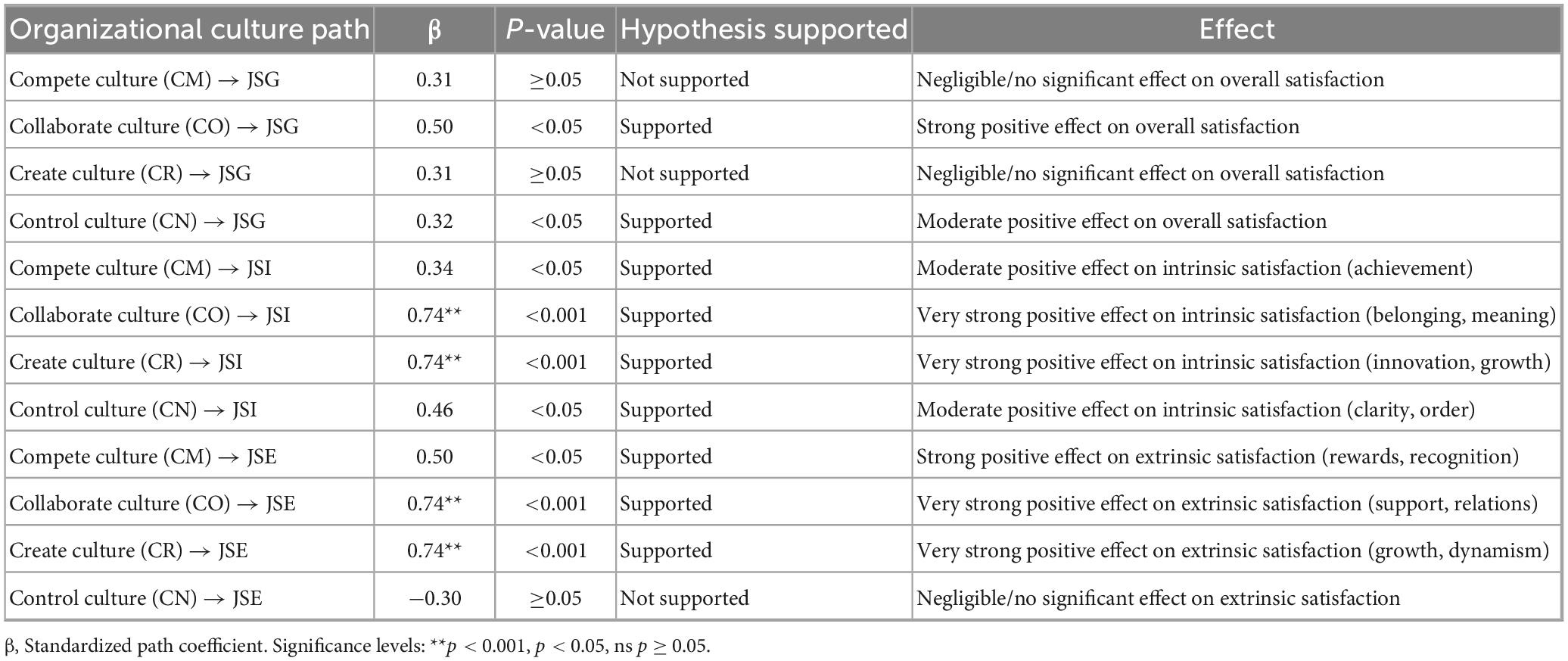
Table 8. Structural path analysis results: organizational culture predicting job satisfaction dimensions.
Structural equation modeling (SEM) was employed to empirically examine the proposed direct structural connections between four types of organizational culture Collaborate (CO), Create (CR), Compete (CM), and Control (CN) and three aspects of job satisfaction among academic staff: General (JSG), Intrinsic (JSI), and Extrinsic (JSE). The Collaborate culture emphasizes internal unity and teamwork; the Create culture centers on innovation and adaptability; the Compete culture stresses market orientation and results; and the Control culture focuses on stability and structure. Table 8 summarizes the standardized path coefficients (β), significance levels, and hypothesis support derived from the SEM analysis.
The analysis revealed distinct influence patterns associated with each cultural type. The Collaborate Culture (CO) emerged as a significant positive predictor, markedly enhancing JSG (β = 0.50, p < 0.05), JSI (β = 0.74, p < 0.001), and JSE (β = 0.74, p < 0.001). The identical beta coefficients for the effect of Create culture on Intrinsic and Extrinsic satisfaction are noteworthy. This may suggest that, in the perception of the respondents, the benefits of an innovative and dynamic culture such as opportunities for growth (intrinsic) and recognition for novel contributions (extrinsic)–are so conceptually intertwined that they exert a similarly powerful and undifferentiated positive effect on both facets of satisfaction. The Control (CN) Culture displayed a more complex pattern, significantly predicting higher GJS and IJS, but its effect on EJS was negative and not statistically significant. Although not statistically significant, the negative trend (β = −0.30) for the effect of Control culture on EJS is theoretically interesting. It may suggest that while academic staff appreciate the order and clarity a Control culture provides (enhancing IJS), the associated rigidity and bureaucratic procedures are perceived as hindering extrinsic rewards like timely promotions or flexible benefits.
These findings robustly support hypotheses H1a (CO → JSG), H1b (CO → JSI), and H1c (CO → JSE), highlighting the extensive advantages of a collaborative environment in augmenting job satisfaction. The Create Culture (CR) demonstrated notable positive effects, particularly on JSI (β = 0.74, p < 0.001) and JSE (β = 0.74, p < 0.001), thereby strongly supporting H2b (CR → JSI) and H2c (CR → JSE). However, its impact on JSG (β = 0.31, p ≥ 0.05) was not statistically significant, leaving H2a (CR → JSG) unsupported. This suggests that while innovation and adaptability enhance certain aspects of satisfaction, they do not necessarily elevate overall job contentment.
The Compete Culture (CM) exhibited a significant positive effect on JSI (β = 0.34, p < 0.05) and an even stronger positive effect on JSE (β = 0.50, p < 0.05), thereby supporting H3b (CM → JSI) and H3c (CM → JSE). However, its influence on JSG (β = 0.31, p ≥ 0.05) was not significant, and thus H3a (CM → JSG) was not supported. These results imply that a results-oriented culture enhances satisfaction related to achievement and external rewards but does not necessarily improve general satisfaction. The Control Culture (CN) displayed a more complex pattern. It significantly predicted higher JSG (β = 0.32, p < 0.05) and JSI (β = 0.46, p < 0.05), supporting H4a (CN → JSG) and H4b (CN → JSI), indicating that structure and predictability positively contribute to general and intrinsic satisfaction. Conversely, its effect on JSE was negative but not statistically significant (β = −0.30, p ≥ 0.05), leaving H4c (CN → JSE) unsupported.
Figure 3 provides a visual representation of the final estimated structural model, illustrating the latent variables corresponding to the four organizational culture types (CO, CR, CM, CN) and the three dimensions of job satisfaction (JSG, JSI, JSE), along with their respective observed indicators and associated measurement errors. The figure depicts the significant positive intercorrelations identified among the culture types, with correlation coefficients ranging from r = 0.57 to r = 0.74, indicating that these orientations frequently coexist. Notably, it visually summarizes the structural paths tested, emphasizing the direct effects of each culture type on the satisfaction dimensions, as quantified in Table 8. The model highlights the substantial and broad positive influence of Collaborate Culture (CO), the strong yet more targeted effects of Create Culture (CR) and Compete Culture (CM) primarily on intrinsic and extrinsic satisfaction, and the nuanced positive impacts of Control Culture (CN) on general and intrinsic satisfaction. The evaluation of standard model fit indices (e.g., χ2/df, CFI, TLI, RMSEA, SRMR, as reported elsewhere in the Sections “Methodology” or “Results”) confirmed the adequacy of this structural model.
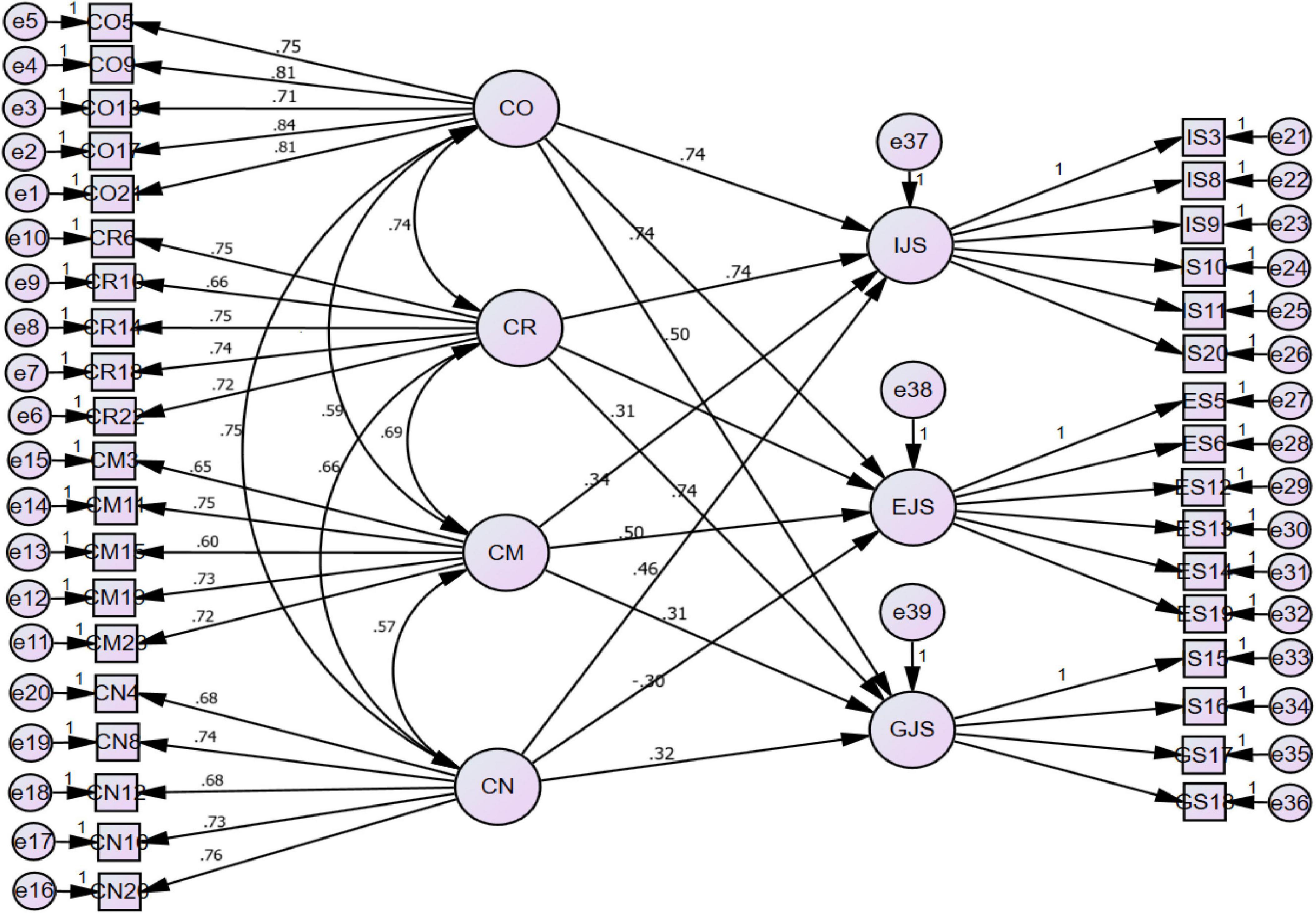
Figure 3. Final structural equation model of organizational culture predicting job satisfaction dimensions.
The structural analysis offers persuasive evidence that different types of organizational culture have unique effects on the job satisfaction of academic staff. The Collaborate culture stands out for its overall positive influence, while the Create and Compete cultures notably improve certain aspects of both intrinsic and extrinsic satisfaction. The Control culture’s impact is more selective, enhancing general and intrinsic satisfaction but showing no significant link to extrinsic satisfaction in this study. These findings offer valuable insights for higher education institutions seeking to improve the well-being of academic staff through targeted cultural development efforts.
Discussion
This study investigates the influence of various dimensions of organizational culture specifically Collaborate (Clan), Create (Adhocracy), Compete (Market), and Control (Hierarchy) on job satisfaction (General, Intrinsic, Extrinsic) among academic staff in Somaliland’s higher education institutions (HEIs) using Structural Equation Modeling (SEM). The analysis revealed that Control (Hierarchy) and Collaborate (Clan) cultures are predominant in Somaliland HEIs, whereas Create (Adhocracy) and Compete (Market) cultures are less prevalent. The frequent observation of clan-like collaboration in academic settings is noted (Aziz et al., 2021). From a psychological perspective, this dual focus reflects a fundamental tension in a post-conflict academic environment: the need to establish order and procedural justice (Control) to create a baseline of psychological safety, while simultaneously leveraging collectivist societal norms to foster a sense of belonging and community (Collaborate).
The SEM analysis identified Collaborate (Clan) culture as the most influential factor, significantly enhancing all three dimensions of job satisfaction. This finding strongly suggests that a culture promoting teamwork, mutual support, and participation is the most effective lever for improving employee morale. This aligns with research from other developing contexts, such as that by Iqbal et al. (2023) in Pakistan, which also found collaborative and supportive cultures to be powerful predictors of positive employee outcomes. However, the dominance of Control culture in Somaliland, unlike in more stable systems, suggests a unique contextual emphasis on structure as a primary organizational need. A key takeaway is that fostering a sense of community and psychological safety is not a “soft” initiative but a primary driver of overall job satisfaction.
The finding that Creates (Adhocracy) and Compete (Market) cultures positively impacted intrinsic and extrinsic satisfaction but not general satisfaction is also significant. This implies that while innovation and achievement are valued, they must be balanced with overall institutional support to translate into comprehensive job contentment. To leverage the benefits of a Collaborate culture, for instance, universities could implement structured peer-mentoring programs and cross-departmental research teams. To mitigate the negative aspects of a Control culture while retaining necessary structure, leadership could focus on “supportive accountability” workshops that train managers to enforce procedures without undermining staff autonomy and psychological well-being.
Policy implications
This study offers essential recommendations for policymakers in Somaliland’s higher education sector. The positive influence of a Collaborate (Clan) culture suggests that institutions should prioritize teamwork, mentorship, and supportive leadership. A concrete policy recommendation would be for the National Commission for Higher Education (NCHE) to incorporate metrics related to collaborative culture and staff well-being into its institutional accreditation standards. The beneficial effects of Create (Adhocracy) and Compete (Market) cultures underscore the importance of fostering these orientations. The complex role of Control (Hierarchy) culture necessitates maintaining essential structures while avoiding bureaucratic rigidity.
Conclusion
This study examined the relationship between organizational culture and job satisfaction in Somaliland HEIs. The findings indicated that the Collaborate (Clan) culture significantly influences all facets of job satisfaction. The study confirmed the predominance of Collaborate and Control cultures and the low levels of extrinsic job satisfaction. This research validates the Competing Values Framework within Somaliland’s context and demonstrates its varied impacts on job satisfaction.
Study limitations
While this study offers valuable insights, it is important to recognize several limitations. Firstly, the research utilized a cross-sectional approach, which limits the ability to definitively establish causality. Secondly, the study exclusively depended on self-reported survey data, which is prone to common method bias. Efforts were made to mitigate this bias during the research design by guaranteeing participant anonymity and ensuring the psychological separation of questionnaire sections, but its potential influence cannot be entirely discounted. Additionally, the generalizability of the findings may be constrained by the specific characteristics of the participating institutions.
Recommendations for future research
In light of the findings and limitations, several avenues for future research are proposed. Longitudinal research designs should be employed to investigate causal relationships over time. From an educational psychology perspective, future studies could investigate the mediating role of academic self-efficacy in the relationship between Adhocracy culture and teaching quality, or a qualitative study could explore how societal clan-based structures influence faculty’s perception of fairness in promotion (EJS), which this study found to be low. Mixed-methods approaches could provide a richer context, and exploring potential mediating or moderating variables would allow for the development of more complex theoretical models.
Data availability statement
The raw data supporting the conclusions of this article will be made available by the authors, without undue reservation.
Ethics statement
The studies involving humans were approved by the Institutional Research Ethics Review Committee, College of Education and Behavioral Sciences, Haramaya University, Ethiopia. In addition, local authorization for data collection and ethical compliance was granted by the Research and Scholarship Office, Somaliland Commission for Higher Education. The studies were conducted in accordance with the local legislation and institutional requirements. The participants provided their written informed consent to participate in this study.
Author contributions
MC: Formal analysis, Data curation, Methodology, Conceptualization, Writing – original draft. BK: Writing – review & editing, Investigation, Supervision, Validation. DG: Writing – review & editing, Supervision, Validation, Investigation. FD: Supervision, Investigation, Validation, Writing – review & editing.
Funding
The author(s) declare that no financial support was received for the research and/or publication of this article.
Conflict of interest
The authors declare that the research was conducted in the absence of any commercial or financial relationships that could be construed as a potential conflict of interest.
Generative AI statement
The author(s) declare that no Generative AI was used in the creation of this manuscript.
Any alternative text (alt text) provided alongside figures in this article has been generated by Frontiers with the support of artificial intelligence and reasonable efforts have been made to ensure accuracy, including review by the authors wherever possible. If you identify any issues, please contact us.
Publisher’s note
All claims expressed in this article are solely those of the authors and do not necessarily represent those of their affiliated organizations, or those of the publisher, the editors and the reviewers. Any product that may be evaluated in this article, or claim that may be made by its manufacturer, is not guaranteed or endorsed by the publisher.
References
Abawa, A., and Obse, H. (2024). Organizational culture and organizational performance: Does job satisf action mediate the relationship? Cogent Bus. Manage. 11:2324127. doi: 10.1080/23311975.2024.2324127
Ahmad, A. (2018). The relationship among job characteristics organizational commitment a nd employee turnover intentions. J. Work-Appl. Manage. 10, 74–92. doi: 10.1108/jwam-09-2017-0027
Akanji, B., Mordi, C., Ituma, A., Adisa, T. A., and Ajonbadi, H. (2020). The influence of organisational culture on leadership style in higher education institutions. Pers. Rev. 49, 709–732. doi: 10.1108/pr-08-2018-0280
Al Habsi, R., and Al Dhuhli, R. (2023). The mediating role of job satisfaction in the relationship between org anizational culture and job commitment among employees in the ministry of education in the sultanate of Oman. Tech. Soc. Sci. J. 51, 34–68. doi: 10.47577/tssj.v51i1.10036
Aziz, H. M., Othman, B. J., Gardi, B., Ahmed, S. A., Sabir, B. Y., Ismael, N. B., et al. (2021). Employee commitment: The relationship between employee commitment and job satisfaction. J. Human. Educ. Dev. 3, 54–66. doi: 10.22161/jhed.3.3.6
Batugal, M. L., and Tindowen, D. (2019). Influence of organizational culture on teachers’ organizational commit ment and job satisfaction: The case of catholic higher education insti tutions in the Philippines. Univ. J. Educ. Res. 7, 2432–2443. doi: 10.13189/ujer.2019.071121
Byrne, B. M. (2013). Structural Equation Modeling with Mplus: Basic Concepts, Applications, and Programming. London: Routledge.
Cameron, K. S., and Quinn, R. E. (1999). Diagnosing and changing organizational culture: Based on the competing values framework. Addison-Wesley.
Chaman, S., Zulfiqar, S., Shaheen, S., and Saleem, S. (2021). Leadership styles and employee knowledge sharing: Exploring the mediat ing role of introjected motivation. PLoS One 16:e0257174. doi: 10.1371/journal.pone.0257174
Collier, J. (2020). Applied Structural Equation Modeling Using AMOS: Basic to Advanced Techniques. London: Routledge.
Cresswell, F. V., Bangdiwala, A. S., Bahr, N. C., Trautner, E., Nuwagira, E., Ellis, J., et al. (2018). Can improved diagnostics reduce mortality from Tuberculous meningitis? Findings from a 6.5-year cohort in Uganda. Wellcome Open Res. 3:64. doi: 10.12688/wellcomeopenres.14610.2
Gebretsadik, D. M. (2020). Impact of organizational culture on the effectiveness of public higher educational institutions in Ethiopia. Int. J. Leadersh. Educ. 25, 823–842. doi: 10.1080/13603124.2020.1722248
Hair, J. F., Risher, J. J., Sarstedt, M., and Ringle, C. M. (2019). When to use and how to report the results of PLS-SEM. Eur. Bus. Rev. 31, 2–24. doi: 10.1108/EBR-11-2018-0203
Hu, L., and Bentler, P. M. (1999). Cutoff criteria for fit indexes in covariance structure analysis: Conventional criteria versus new alternatives. Struct. Equat. Model. 6, 1–55. doi: 10.1080/10705519909540118
Iqbal, S., Taib, C. A., and Razalli, M. R. (2023). The nexus between leadership styles and organizational performance: The mediating role of quality culture. Qual. Assurance Educ. 31, 600–615. doi: 10.1108/qae-03-2023-0038
Kasalak, G., Güneri, B., Ehtiyar, V. R., Apaydin, Ç, and Türker, G. Ö (2022). The relation between leadership styles in higher education institution s and academic staff’s job satisfaction: A meta-analysis study. Front. Psychol. 13:1038824. doi: 10.3389/fpsyg.2022.1038824
Kebede, A. M., and Demeke, G. W. (2017). The influence of leadership styles on employees’ job satisfaction in E thiopian Public Universities. Contemp. Manage. Res. 13, 165–176. doi: 10.7903/cmr.17668
Khan, A. J., Bhatti, M. A., Hussain, A., Ahmad, R., and Iqbal, J. (2021). Employee job satisfaction in higher educational institutes: A review o f theories. J. S. Asian Stud. 9, 257–266. doi: 10.33687/jsas.009.03.3940
Khan, T. M., Khan, N. A., and Khan, S. (2021). The impact of organizational culture on job satisfaction in universities of Pakistan: A competing values framework perspective. Pak. J. Soc. Res. 3, 340–351. doi: 10.52567/pjsr.v3i3.256
Kline, R. B. (2023). Principles and Practice of Structural Equation Modeling. New York, NY: Guilford publications.
Mabaso, C. M., and Dlamini, B. I. (2021). Recent study on the impact of compensation and benefits on job satisfaction. International Journal of Research in Business and Social Science 10, 140–149. doi: 10.20525/ijrbs.v10i3.1118
Mesfin, D., Woldie, M., Adamu, A., and Bekele, F. (2020). Perceived organizational culture and its relationship with job satisfa ction in primary hospitals of Jimma zone and Jimma town administration, correlational study. BMC Health Serv. Res. 20:438. doi: 10.1186/s12913-020-05319-x
Mgaiwa, S. J. (2023). Predicting academics’ job satisfaction from their perceived leadership styles: Evidence from Tanzania. Cogent Psychol. 10:2156839. doi: 10.1080/23311908.2022.2156839
Mohamed, M., Mohamud, F., Mohamud, I., and Farah, M. (2024). Examining the effect of workplace relationships on job satisfaction among faculty members at private universities in Mogadishu. Int. J. Organ. Leadersh. 13, 377–393. doi: 10.33844/ijol.2024.60420
Nebojša, P., Marija, I., and Kristina, Č (2020). Organizational culture and job satisfaction among university professor s in the selected Central and Eastern European Countries. Stud. Bus. Econ. 15, 168–184. doi: 10.2478/sbe-2020-0052
Sara, A., Fereshteh, E., and Hadi, M. (2021). Investigating the relationship between organizational culture and job satisfaction among employee of esfarayne faculty of medical sciences i n 2017. Sci. J. Nurs. Midwifery Paramed. Facul. 6, 22–30.
Ser, E. M., and Webber, J. K. (2024). Herzberg’s motivational factors applied to generational influencers. J. Manage. Hist. doi: 10.1108/jmh-01-2024-0002
Keywords: organizational culture, job satisfaction, higher education, structural equation modeling, Somaliland
Citation: Cumar MA, Kidaneb BZ, Golgac DN and Dinsa F (2025) Organizational culture and academic staff satisfaction in Somaliland higher education: evidence from structural equation modeling. Front. Educ. 10:1635607. doi: 10.3389/feduc.2025.1635607
Received: 26 May 2025; Accepted: 04 August 2025;
Published: 04 September 2025.
Edited by:
Rolando Salazar Hernandez, Universidad Autónoma de Tamaulipas, MexicoReviewed by:
Anik Yuesti, Universitas Mahasaraswati Denpasar, IndonesiaSaut Gracer Sijabat, Politeknik STIA LAN Jakarta, Indonesia
Copyright © 2025 Cumar, Kidaneb, Golgac and Dinsa. This is an open-access article distributed under the terms of the Creative Commons Attribution License (CC BY). The use, distribution or reproduction in other forums is permitted, provided the original author(s) and the copyright owner(s) are credited and that the original publication in this journal is cited, in accordance with accepted academic practice. No use, distribution or reproduction is permitted which does not comply with these terms.
*Correspondence: Mukhtaar Axmed Cumar, ci5oYWFnaUBhbW91ZC5lZHUuc28=
 Mukhtaar Axmed Cumar
Mukhtaar Axmed Cumar Befekadu Zeleke Kidaneb3
Befekadu Zeleke Kidaneb3 Dawit Negassa Golgac
Dawit Negassa Golgac